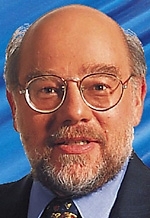This is an edited version of an article that was originally published in the January-February issue of is&t, the newsletter of Information Services and Technology.
On Nov. 1, Jerrold Grochow (S.B. 1968, S.M., Ph.D.) became vice president for information services and technology at MIT. He has been leading the reorganization of the central department, Information Services and Technology (IS&T), and making rounds throughout the community to hear what IS&T clients have to say. Here are his observations after three months at the helm.
Q. You graduated from MIT and everyone in your immediate family has close ties to MIT. What's changed since you studied here?
A. Thirty-five years ago, MIT didn't have a network and there were only a few computers on campus. Course 6 was electrical engineering--no computer science. So MIT is clearly a different place. I view the Institute as a new place for me to learn about, but also a place that I know and love in a way I can't say about any other organization.
Q. What's in the cards for information technology?
A. In the next five years, we're going to see further expansion in the use of Internet technology via the many new devices coming into popular use. There is already a huge penetration of cell phones with short text messaging, and these devices are starting to have PDA and web browser functionality. Everyone being connected all the time is going to have a big impact on the way we live and work. We're going to have to figure out how to integrate services across a wide range of computing devices, wherever people may be, and as they move around.
Q. What challenges does IS&T face, in the short and long term?
A. As to short-term challenges, I have to acknowledge MIT's financial situation and the budget cuts. Everyone is aware of the situation and concerned about the implications for information services.
First and foremost, IS&T focused on minimizing the impact of the cuts on central services. We are working with several advisory groups to make sure that we set priorities in the best possible way. You can't cut 20 percent of the staff without impact, but we will work with the community to make sure that the business of MIT goes on.
We're also very cognizant of the need for us to look at how we do business. If we can change the way in which we provide certain services, over time we can provide even better services at lower cost.
Q. What have you heard from clients as you've started to make the rounds?
A. Overall, many people are happy with the computing services they get from IS&T. However, others are not so happy, whether it's because they don't have good wireless access or sufficient bandwidth or enough personalized support. Sometimes the problem is with IS&T, sometimes it's a broader issue of how IT services are provided at MIT.
The challenge for IS&T is to understand those areas where clients are not satisfied and find ways to work with them to improve the situation. In some ways, it's that simple. But if what's going to make them happy is gigabit service to their desktop, that will cost a lot, and we will have to find creative ways to meet their needs.
Q. You're both head of a department (IS&T) and the vice president for information services and technology at MIT. Are these two different roles?
A. I believe they are two overlapping roles. As a whole, MIT does not know how much it is spending on information services and technology. One of my jobs is to answer that question and bring to the surface enough information so that decision makers at all levels can make better resource allocations.
IS&T has less than half the people providing information services on this campus. There are at least 20 other groups on campus that provide IT services. One of my goals as an MIT vice president, not just as a department head, is to make it possible for all these people to work together to find ways to provide better information services to MIT.
I've started a group called IT Leaders, and I'm very pleased that many people who head these various groups accepted my invitation to meet on an informal basis.
Q. How can members of the community weigh in with you on their technology needs or concerns?
A. Provost Bob Brown and Executive Vice President John Curry will shortly appoint the Information Technology Coordinating Council which will have broad oversight for IT across MIT. This group, which I'll chair, will advise Brown and Curry on higher-level issues and resource allocation decisions.
Also, by forming the IT Leaders group, we now have direct communication with the IT groups in the various departments. And we're working with the members of IT Partners and EdTech Partners as well. So if you talk to your local IT person, that provides an indirect conduit to me. And, of course, I do respond to e-mail!
A version of this article appeared in MIT Tech Talk on March 10, 2004.






